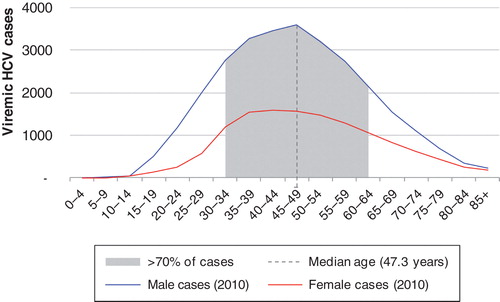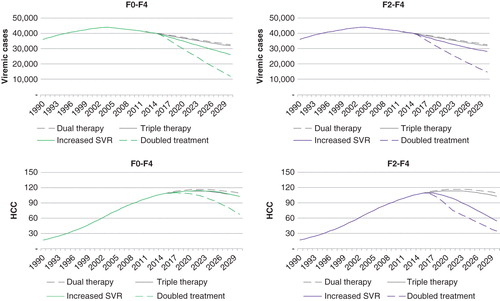Figures & data
Table I. Estimated SVR by genotype and stage of fibrosis at baseline dual therapy (PEG-IFN + RBV), first wave (PEG-IFN + RBV + first generation PI for genotype 1), second wave (NUC + second wave PI or NS5A inhibitor for genotype 1, NUC + RBV for genotype 2/3, and NUC + PEG-IFN + RBV for a few patients) and third wave of new DAAs (IFN-free regimens in different combinations). Real-life SVR estimates for treatment-naïve and -experienced patients are combined to a common estimate.
Figure 1. Age and gender distribution of viremic HCV infections in Sweden in 2010 is shown. Abbreviation: HCV = Hepatitis C virus.

Figure 2. Prediction of future HCV infections and related complications under different treatment strategies is shown: A. prevalence of viremic HCV infections; B. incidence of HCC; C. prevalence of decompensated cirrhosis; D. liver-related mortality. The treatment strategies are: 1. base, dual/triple therapy with PEG-IFN + RBV and first-generation PI for genotype 1, at an annual treatment rate of 1130. Strategies 2–5 consider treatment with future DAAs restricted to F3–F4 fibrosis with different treatment uptake as follows, 2. treat 380 (maintained budget), 3. treat 1130 (maintained number of treated), 4. treat 1430 (a 30% increase), and 5. treat 2260 patients (a doubled increase). Abbreviations: DAA = Direct-acting antiviral; HCC = Hepatocellular carcinoma; HCV = Hepatitis C virus; PEG-IFN = PEGylated interferon; PI = Protease inhibitor; RBV = Ribavirin.

Table II. The impact of different HCV treatment strategies on the liver-related morbidity, mortality, and total viremic infections by 2030, using either no therapy, IFN-based therapies (base, dual/triple) for 1130 patients, or new DAAs in IFN-free regimens for 380 patients (restriction to maintain budget), 760 patients (doubled budget), 1130 (unchanged number), 1430 (30% increase), or 2260 patients (doubled number). The DAA scenarios were treating patients only with fibrosis score ≥F2 or ≥F3.
Figure 3. The effects of treating persons with F0–F4 fibrosis compared with restricting treatment to persons with F2–F4 on the future prevalence of viremic HCV infections and incidence of HCC, beginning in 2015 are shown. The therapies in the figure are: “Dual therapy” with PEG-IFN and ribavirin for 1130 patients annually; “Triple therapy”, adding a first-generation protease inhibitor for genotype 1, treating 1130 patients; “Increased SVR” treating 1130 patients with new highly effective DAAs (IFN-free); and “Doubled treatment” treating 2260 patients with DAAs. Abbreviations: DAA = Direct-acting antiviral; HCC = Hepatocellular carcinoma; HCV = Hepatitis C virus; PEG-IFN = PEGylated interferon; SVR = Sustained virological response.


